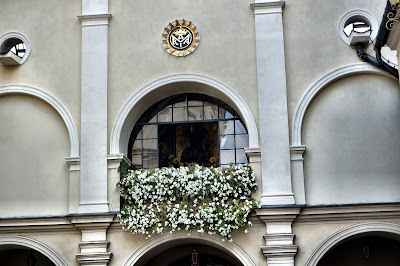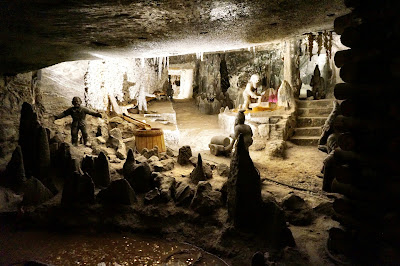After staying in Warsaw for two nights, we headed toward Krakow, the old capital of Poland. Krakow is about 182 miles due south of Warsaw. Our dependable bus driver Garbo would drive his coach to transport us, as he would for the entire duration of our trip. On the way to Krakow, we would first stop at Jasna Gora Monastery.
The majority of Poland’s population is Roman Catholic. Religion plays a very important role in the lives of many Poles. The Catholic Church is regarded as the sanctuary of Polish heritage and culture. It is even more so when Poland ceased to exist as a country for more than 100 years. During that time, and subsequently, when Poland was partitioned and ruled by foreign forces, Poles turned to churches to seek national identity and to feel a sense of spiritual belonging. The religious faith is said to be the common thread that binds Poles together through thick and thin.
Jasna Gora Monastery is 136 miles due southwest of Warsaw. The monastery is the national shrine of Poland and the center of Polish Catholicism. It houses the miraculous icon of Our Lady of Czestochowa, the Black Madonna. It is also the third-largest Catholic pilgrimage site in the world. Pilgrims come to the Chapel of the Black Madonna to worship the icon of Our Lady of Czestochowa, which is displayed in an altar in the chapel.
I was sitting on the wrong side of the bus and wasn’t able to get a picture of the monastery in whole. Here is a picture copied from the internet.
(Click on each picture to get the full-size view)
The following picture shows the soaring bell tower and Gate of John Paul II, one of two entrances into the monastery. The coat of arms on top of the gate is inscribed with the apostolic motto “Totus Tuus” (All Yours). When Pope John Paul II visited the monastery, he entrusted his entire Papal mission with the motto “Totus Tuus, Maria! - All Yours, Mary!”.
Pilgrims from all over the world come to the monastery. I didn’t notice the US flag but I am sure it’s there somewhere.
Another angle of the bell tower and the entrance to the basilica.
This is the entrance to the Chapel of the Black Madonna. Our visit was on a Sunday and there were many worshipers. Through the window above the chapel entrance, a replica of the icon of Our Lady of Czestochowa could be seen.

Inside the chapel, a stream of churchgoers filled every standing room. Our group tried to squeeze ourselves through the crowd and moved toward the altar to see the real icon.
“What do they think they’re doing @##$%?”
While nudging and bypassing churchgoers to move forward, I could sense these questions in their minds just by looking at the puzzling faces. (Rosaline and I were two of only a handful Asian-looking persons in the chapel at that time, and we certainly looked very conspicuous). One older gentleman signaled with his disapproving finger at me to remove my hat (a guilty faux pas on my part)
The chapel was just too packed with so many people that we barely could move without bumping into others. In front was the Altar of the Crucifix, one of six altars in the chapel.
This was as far as we could go. We never got to any proximity to the main altar that houses the icon of the Black Madonna.
This is the main nave of the basilica with the main altar at the far end.
A closer view of the main altar.
A Sunday mass was also being conducted from an outdoor altar.
The open space in front of the outdoor altar is filled with throngs of pilgrims on August 15 every year for the Feast of the Assumption. Up to half a million people congregate around the monastery and over 2000 buses are used to transport them.
After the monastery, it was another 2-hour drive for our bus to reach Krakow. We checked into our hotel, Radisson Blu Hotel Krakow. The rest of day is free for roaming in the city. We opted to join the optional tour to Wieliczka Salt Mine. The salt mine started its operation from the 13th century until 2007. It is famous for its subterranean salt carvings, which were sculptured by miners over many centuries.
This is the building of the salt mine company. The exterior of the building is unassuming. It gives no sign of its underground treasure.
The salt mine has been designated by UNESCO as a World Heritage Site since 1978.
We took the elevator down to, and later up from, the mine. Each elevator car has room for eight passengers.
There are many corridors in the salt mine. This sign says that the area was excavated in the 17th century.
This is one of many corridors that has wood planks on the tunnel wall.
There are also many corridors that show the bare wall of salt. You can actually taste the salt.
Although we could not smell the salt, the saline aerosol in the tunnel near an underground lake is said to have therapeutic effects on upper body wellness.
There are many statues carved out of rock salt.
This is the scene of Snow White and Seven Dwarfs, all carved out of rock salt.
There is a voluminous and most impressive subterranean Catholic chapel, called The Chapel of Saint Kinga. It’s also known as the Underground Salt Cathedral of Poland.
Sculptures on the wall of the chapel.

Leonardo's "The Last Supper", carved in salt
Salt statue of Pope John Paul II
Near the altar of Saint Kinga Chapel.
After the salt mine, it was a short drive back to the city of Krakow. It was about the nightfall when we reached Krakow, just in time for the dinner provided by Gate 1 at a restaurant in the hotel.
After dinner, Rosaline and I took a short walk to the nearby Main Market Square (the Rynek Glowny). We would come back the next day to get a better view of the square. This picture shows the Renaissance-style Cloth Hall on the left and Town Hall Tower on the right.
At one corner of the big square stands St. Mary’s Basilica with Gothic towers.
The bronze statue on the left is for a Polish poet of the 19th century.
In front of a big hollow bronze head at the bottom of the Town Hall Tower.
Witnessing the devotion at the monastery renewed our belief in the goodness of faith.-Joe
Inhaling saline air in the salt mine invigorated our aging and declining health.
Rewards of visiting these two places - our mind and body felt rejuvenated.
May we stay forever young as if we were still in our twenties.




































No comments:
Post a Comment